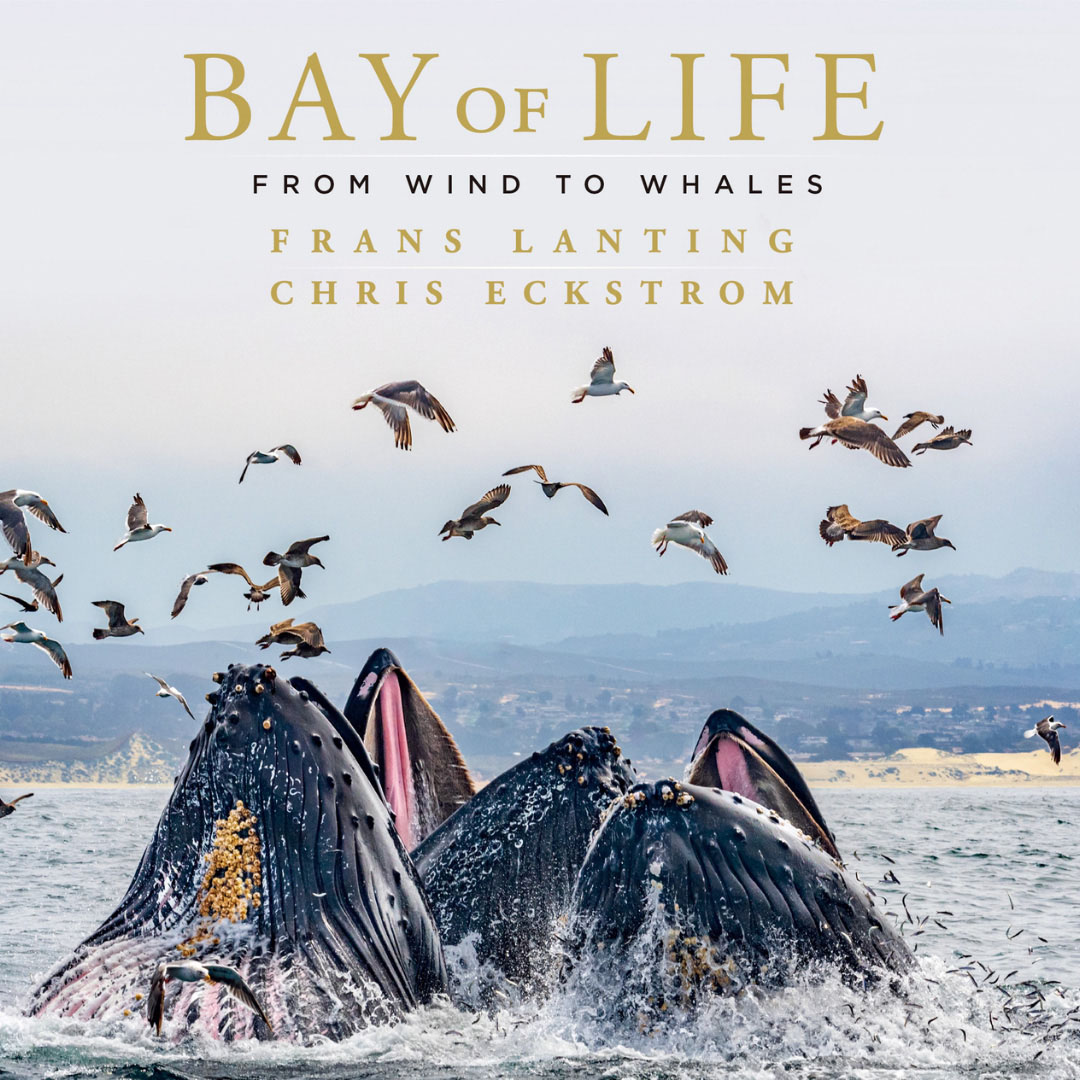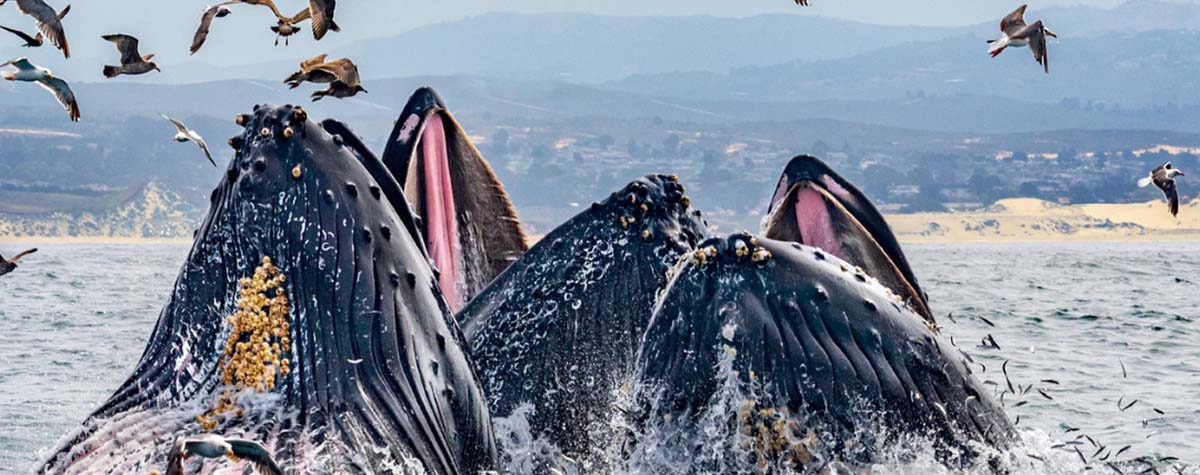
![]()
BAY of LIFE: From Wind to Whales
A New Photo Book by Frans Lanting & Chris Eckstrom
I recently received a copy of Frans Lanting’s newest book, Bay of Life: From Wind to Whales, published hot off the press by Earth Aware Editions, 2022. This large, hardbound coffee-table-type book is a visual celebration of the Monterey Bay Area, a place that Frans and Chris have called home for decades. As one of the most naturally biodiverse areas on the continent, and arguably one of the most beautiful and fantastic areas in a state filled with magnificent locations, Bay of Life is a true homage to the Monterey Bay and its surrounding regional landscapes.
I should preface this to say I count myself among many who consider Frans Lanting to be one of, if not the best natural history photographers on the planet. Bay of Life is clearly a personal passion project that brings his viewers a grand collection of unparalleled scenes and subjects. It is in this arena of passionate and visually expressive conservation photographers and artists where I look upon these types of works as done “By the Planet, of the Planet, and for the Planet.” The Monterey Bay is only a very tiny slice of this planet, yet Bay of Life turns an incredibly revealing lens at an often under-appreciated hotbed of biodiversity.
Bay of Life e is a true keepsake body of work that will grace personal libraries anywhere. The magnificent cover image of feeding Humpback whales encircled by seagulls adorns an impressive 240 pages of thick, tactile paper in a 10.5” x 11.5” format. In addition to an Introduction by Chris and Frans, Bay of Life contains a Forward written by Monterey-born Leon Panetta, a former California State Congressional Representative before taking on other notable national offices, and who’s the current Co-Chair of the Monterey Bay Marine Sanctuary Foundation. There is also a Preface contributed by Julie Packard, the Monterey Bay Aquarium’s Executive Director.
I should mention that Bay of Life is my personal favorite type of photo book; it is, in essence, a true Photo Essay. The book is light on text and heavy on photos, presented large with extended photo captions providing the majority of informational text.
Bay of Life covers an area that includes part of the California coast once aptly described as the greatest meeting point of land and sea on the planet. As an homage, both of these areas receive due coverage. Offshore, the book looks at Monterey Bay proper as well as the broader scope of the Monterey Marine Sanctuary, which runs north to Half Moon Bay and south beyond Big Sur. The lands covered are those that serve as the greater watershed which feeds into the Monterey Bay, and reaches into places like the Ventana Wilderness and Salinas Valley, as well as the coastal corridor that abuts the southern fringes of the greater San Francisco Bay Area.
To celebrate the life and environs which lie within the Bay of Life, the book presents a series of three distinct thematic sections, including Seasons, Habitats, and Footprints. Within the obvious seasonal breakdown are images of beautiful spring wildflowers, annual migrations, summer fog, and winter snows blanketing the coastal range. Habitats span the largest portion of the book and highlight environs from forest and grasslands, to tidepools, then out into the bay itself, submerging beneath the waves beyond kelp forests into the dark depths of the submarine Monterey Canyon, whose mile-deep canyon walls are the underwater equivalent of the Grand Canyon. Finally, Footprints details the human element and its connection and impact within the Monterey Bay region. This section leads with a look at the original inhabitants of the area, the Ohlone and Esselen, and the historical impacts on the area that occurred following the Gold Rush and the massive number of people that flooded into the state. Finally, as a celebration of the environment, Bay of Life gives a nod of the lens to a number of conservational and sustainability efforts.
The book interestingly concludes with a number of reference maps meant to give the reader additional insights into the various areas of concern. Often, one might expect to see this content at the front of a book to give added upfront informational clarity. However, that seems to be a dry and educational approach, like having to do your homework before getting dessert. I liked the additional maps were placed as a suffix feature, because not only did I get to have dessert first, but by the time all that glorious imagery was fully digested, it was much easier to appreciate what the maps were highlighting.
I’ve saved the best for last: The Photos themselves. Bay of Life is filled with fantastic and compelling photography followed by more fantastic and compelling photography. The extended captions provide just enough information to make itself and the photo relevant to each other, but the photo is always the dominant aspect. There isn’t a single small photo in the book (as best as I recall) and there are many glorious double-page spreads.
Most of the photos in Bay of Life reinforce why Frans Lanting is considered one of the best nature photographers working in the field. In addition to the amazing front and back cover images, the latter featuring a surfer set against a giant winter wave, there were many times I found myself simply saying, “Wow!” Especially notable among these were several images in the frontier of the book including a forest fire raging along the Big Sur coast and a sea of elephant seals hauled out on an area beach,
The other aspect that makes Frans such a good documentary photographer is the way he captures so many facets of the natural world with a sense of intimacy and a visceral connection to his subjects. It doesn’t seem to matter whether the subject is the underside of a mushroom, a coastal amphibian, newly hatched fish, or a pair of fighting juvenile male elephant seals. Another personal favorite image of mine was the infrared image of the mother bobcat and cub beneath an oak tree.
One thing different from Frans’ other books, and which I appreciated about Bay of Life – presented as it was, a Partnership Project – was the notable amount of imagery provided by outside photographers. Most of these were of underwater subjects, without whose inclusion would have silenced a major part of the story that is the Bay of Life. Normally, I might say it would be a tough bar to match the visual quality of Frans Lanting’s photography. However, most of the work from these outside photographers is every bit at the level you would expect from something seen in National Geographic and which adds many important flavors to the book. Among some of the standout contributed images that caught my attention were a Great White shark off a nearby beach, a pair of breaching whale images, and a shot of a sea lion swimming underwater in a kelp forest while investigating a discarded n95 Covid-19 facemask.
Finally, there’s some fascinating deepsea imagery provided by the Monterey Bay Aquarium Research Institute and NOAA, the National Oceanic and Atmospheric Administration.
The only regret I have about the Bay of Life is not being able to share any of the images from this magnificent book with you here. However, you can find out much more about the book, see some of the fantastic photos along with a small selection of videos at the Bay of Life website.
You can purchase Bay of Life: From Wind to Whales by visiting the website Bay of Life. The cover price is $60, and a special Collector’s Edition is available for $500. Bay of Life is also available on Amazon.com (non-affiliate link), and hopefully through your local booksellers.
—![]()
 Gary Crabbe is an award-winning commercial and editorial outdoor travel photographer and author based out of the San Francisco Bay Area, California. He has seven published books on California to his credit, including “Photographing California; v1-North”, which won the prestigious 2013 IBPA Benjamin Franklin Gold Medal Award as Best Regional title. His client and publication credits include the National Geographic Society, the New York Times, Forbes Magazine, TIME, The North Face, Subaru, L.L. Bean, Victoria’s Secret, Sunset Magazine, The Nature Conservancy, and many more. In 2018, The USPS selected a nearly-unprecedented seven of Gary’s photographs to become U.S. Postage ‘Forever’ Stamps as part of the O Beautiful collection. Gary is also a photography instructor and consultant, offering both public and private photo workshops, as well as being a professional Photo Editor and Content Creator.
Gary Crabbe is an award-winning commercial and editorial outdoor travel photographer and author based out of the San Francisco Bay Area, California. He has seven published books on California to his credit, including “Photographing California; v1-North”, which won the prestigious 2013 IBPA Benjamin Franklin Gold Medal Award as Best Regional title. His client and publication credits include the National Geographic Society, the New York Times, Forbes Magazine, TIME, The North Face, Subaru, L.L. Bean, Victoria’s Secret, Sunset Magazine, The Nature Conservancy, and many more. In 2018, The USPS selected a nearly-unprecedented seven of Gary’s photographs to become U.S. Postage ‘Forever’ Stamps as part of the O Beautiful collection. Gary is also a photography instructor and consultant, offering both public and private photo workshops, as well as being a professional Photo Editor and Content Creator.
Follow me on FACEBOOK – INSTAGRAM – TWITTER
*** If you like this post, I would greatly appreciate it if you’d consider sharing this with your friends using one of the Social Media sharing buttons located at the top or bottom of this post. You can also sign up to receive free updates by email when future posts are made to this blog.
![]()
Did you enjoy this material? If yes, please Share This Post!
![]()


Seasons Greetings to you and your family, Gary!